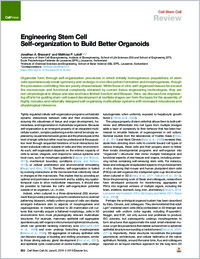Engineering Stem Cell Self-organization to Build Better Organoids.
- Brassard JA Laboratory of Stem Cell Bioengineering, Institute of Bioengineering, School of Life Sciences (SV) and School of Engineering (STI), Ecole Polytechnique Fédérale de Lausanne (EPFL), Lausanne, Switzerland.
- Lutolf MP Laboratory of Stem Cell Bioengineering, Institute of Bioengineering, School of Life Sciences (SV) and School of Engineering (STI), Ecole Polytechnique Fédérale de Lausanne (EPFL), Lausanne, Switzerland; Institute of Chemical Sciences and Engineering, School of Basic Science (SB), EPFL, Lausanne, Switzerland. Electronic address: matthias.lutolf@epfl.ch.
- 2019-06-08
Published in:
- Cell stem cell. - 2019
biofabrication
biomaterial
extracellular matrix
morphogenesis
organoid
patterning
self-organization
stem cell
symmetry breaking
tissue engineering
Animals
Cell Culture Techniques
Cell Differentiation
Cell Proliferation
Humans
Induced Pluripotent Stem Cells
Morphogenesis
Organoids
Regenerative Medicine
Tissue Engineering
English
Organoids form through self-organization processes in which initially homogeneous populations of stem cells spontaneously break symmetry and undergo in-vivo-like pattern formation and morphogenesis, though the processes controlling this are poorly characterized. While these in vitro self-organized tissues far exceed the microscopic and functional complexity obtained by current tissue engineering technologies, they are non-physiological in shape and size and have limited function and lifespan. Here, we discuss how engineering efforts for guiding stem-cell-based development at multiple stages can form the basis for the assembly of highly complex and rationally designed self-organizing multicellular systems with increased robustness and physiological relevance.
- Language
-
- English
- Open access status
- bronze
- Identifiers
-
- DOI 10.1016/j.stem.2019.05.005
- PMID 31173716
- Persistent URL
- https://folia.unifr.ch/global/documents/105524
Statistics
Document views: 16
File downloads:
- fulltext.pdf: 0
